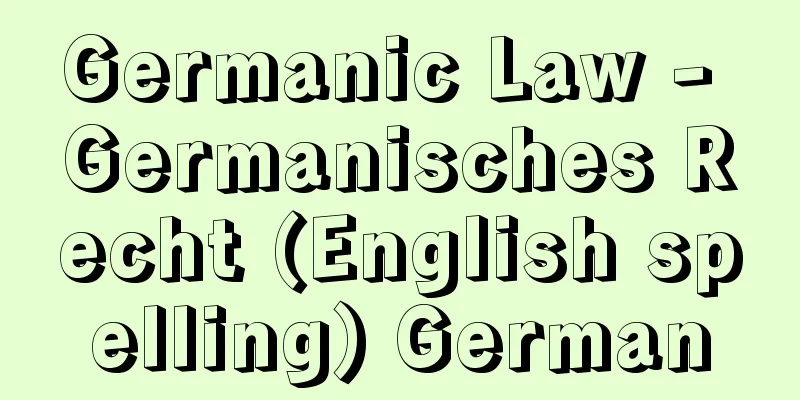Germanic Law - Germanisches Recht (English spelling) German

|
It is generally used to mean the law inherent to the Germanic people. The concept of Germanic law began to be considered in comparison with Roman law as early as the 17th century. However, it became more noticeable when the liberal German unification movement gained momentum in the late 1830s due to the influence of the July Revolution in France, and a major Germanist movement gained momentum. The Germanist journal "German Law and German Legal Studies" was launched (1839), and the Germanisten Congress was held (1846, 1847). At this conference, in opposition to Pandektent jurisprudence, it was argued that German ordinary law (gemeines Recht) was a mixture of Roman and Germanic elements. This prompted research into Germanic elements, and eventually the idea of a one-sided emphasis on Germanic elements in Germany and the elimination of Roman elements was born in the form of Germanic law as a timeless concept, and this idea was inherited by Nazi jurisprudence. Therefore, the concept of Germanic law is not very clear and has been used in various ways, such as (1) law of the Old Germanic period, (2) law common to the Germanic peoples, and (3) law specific to Germany, and it is doubtful whether this concept is effective in clarifying European law. If it is effective, it would be in the case of Old Germanic law. During the Great Migration, each Germanic tribe lived according to their own customary law. Among them, the West Germanic people who lived in what is now the west of Poland brought their customary law to various parts of Europe during their migration. The Anglo-Saxons traveled to England, and in continental Europe, some tribes created legal codes under the influence of Roman law culture and Christianity, or created codes or law books that included their own customary law. These tribal laws ceased to be practiced during the High Middle Ages, but were established as customary law in each region. In Germany, Roman law (Justinian's law) was adopted around the Middle Ages, and this was integrated with church law (Roman canon law) to become German ordinary law, and was given a supplementary role to customary law. However, customary law was still maintained in rural areas, and formed medieval law, either complementing or opposing Roman canon law. The Germanistins in the 19th century viewed such rural (regional) law as Germanic law, and demanded that the system of these laws be introduced into the German Civil Code. One example of this is the Gebele. [Atsushi Sato] "Roman and Germanic Thought in Civil Law" by Hirano Yoshitaro (1924, Yuhikaku) " "On the Concept of Germanic Law" by Sera Choshiro (included in "Problems in Historical Methodology" 1973, Mokdosha) " "The Flow of European Legal Culture" by Coing, supervised by Ueyama Yasutoshi (1983, Minerva Shobo) [References] | | | |Source: Shogakukan Encyclopedia Nipponica About Encyclopedia Nipponica Information | Legend |
|
一般にゲルマン人の固有法の意味で用いられる。ゲルマン法という概念がローマ法との対比で意識され始めたのはすでに17世紀にさかのぼる。しかしそれが顕著になってきたのは、フランスの七月革命の影響で自由主義的ドイツ統一運動が高揚し、1830年代末からゲルマニステンの一大運動が盛り上がったときであった。ゲルマニステンの機関誌『ドイツ法およびドイツ法学雑誌』の創刊(1839)、ゲルマニステン会議の開催(1846、47)があり、この会議でパンデクテン法学に対抗して、ドイツ普通法gemeines Rechtはローマ的要素とゲルマン的要素が混合したものであるとされた。これをきっかけとしてゲルマン的要素の研究が進められ、やがて時代を超越した概念としてのゲルマン法という形でドイツにおけるゲルマン的要素の一面的強調、ローマ的要素を排除すべきであるとの考え方が生まれ、これがナチス法学に受け継がれた。したがってゲルマン法という概念はそれほど明確なものではなく、(1)古ゲルマン時代の法、(2)ゲルマン人に共通の法、(3)ドイツに固有の法、というように種々の用いられ方をしており、はたしてこれがヨーロッパ法を明らかにするのに有効な概念であるのかどうかは疑わしい。有効であるとすれば、古ゲルマン時代の法の場合であろう。 民族大移動のころのゲルマン各部族はそれぞれ慣習法によって生活していた。そのなかで現在のポーランド西方に住んでいた西ゲルマン人は、その移動によってヨーロッパ各地に彼らの慣習法をもたらした。アングロ・サクソンはイギリスに渡り、ヨーロッパ大陸ではいくつかの部族がローマ法文化とキリスト教の影響を受けて法典をつくったり、あるいは自分たちの慣習法を採録した法典や法書をつくった。これらの部族の法は中世盛期になると行われなくなったが、各地方の慣習法として定着した。ドイツでは、中世の中ごろにローマ法(ユスティニアヌスの法)が継受され、これが教会法と一体となって(ローマ・カノン法)、ドイツ普通法となり、慣習法の補充的役割を与えられるようになった。しかし慣習法は、依然として農村(地域)において維持され、ローマ・カノン法と補い合って、あるいは対立して中世法を形成していた。19世紀のゲルマニステンの主張は、このような農村(地域)法をゲルマン法としてとらえ、ドイツ民法典にこれらの法の仕組みを導入するよう要求したものである。その一つの例としてゲベーレをあげることができる。 [佐藤篤士] 『平野義太郎著『民法におけるローマ思想とゲルマン思想』(1924・有斐閣)』▽『世良晁志郎著『ゲルマン法の概念について』(『歴史学方法論の諸問題』所収・1973・木鐸社)』▽『コーイング著、上山安敏監訳『ヨーロッパ法文化の流れ』(1983・ミネルヴァ書房)』 [参照項目] | | | |出典 小学館 日本大百科全書(ニッポニカ)日本大百科全書(ニッポニカ)について 情報 | 凡例 |
>>: Germanic Tribal Law (Germanic Tribal Law) (English: Volksrechte)
Recommend
Agitating Point
…An abbreviation of the English word agitating po...
Catamaran ship - Catamaran ship
〘Noun〙 (Catamaran) ① A raft made of two or three l...
The Century of Japan
A history book written in the late Heian period. ...
Bereshith; Genesis
The first book of the Old Testament, called Beresh...
Elvis Presley
…He was the biggest postwar star born in American...
Long-tailed broadbill
…It is found in areas from Thailand and Vietnam t...
Sakharov, Andrei Dmitrievich
Born: May 21, 1921, Moscow [Died] December 14, 198...
《Old Father Eterno》 - Oiterueru no Shinpu
…After graduating from the University of Coimbra,...
Indonesian Literature - Indonesian Literature
Literature written in Indonesian, the national lan...
Munich - München (English spelling)
The capital of Bavaria in southeastern Germany. I...
North American Wholesaler - Kitamaidoya
…These merchant rice products were sold throughou...
Cesare Lombroso
Italian physician. Renowned as the founder of cri...
Intermediate exploitation
It refers to the act of intermediates acting as i...
Vienna style action
…This system was improved by Johann Andreas Stein...
Louis XIII - Louis
King of France (reigned 1610-1643). Son of Henry I...









